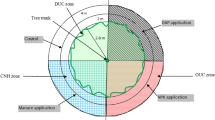Abstract
The interactions between component species in three-tier agroforestry systems were studied on sloping laterite soils of South India for three years. The wood yield of Eucalyptus was found to increase in association with the intercrops, with cassava + groundnut resulting in the best growth of Eucalyptus. Green forage yield of Leucaena was adversely affected by cassava but was improved by inclusion of a short duration seasonal crop. Both spread and mean length of lateral roots of Eucalyptus and Leucaena were restricted by cassava intercropping. Both the tree species were found to reduce the tuber yield of cassava and also the pod yield of both the seasonal crops when grown in association. Monocropping with cassava was found to improve the fertility and an increase in phosphorus and potassium contents of the soil was observed when grown in association with Eucalyptus and Leucaena. Soil fertility fell considerably after three years of cultivation of the tree species. The nutrient uptake by cassava was low when grown in association with perennial species. Both run off and soil loss were effectively reduced when cassava was grown in staggered mounds under Eucalyptus and Leucaena.
Similar content being viewed by others
References
Alexander TG, Sobhana K, Balagopalan M and Mary MV (1980) Taungya in relation to soil properties, soil degradation and soil management. Res Rep 4. Kerala (India): Kerala Forest Research Institute, Peechi
Diaz RO and Pinstrep-Anderson P (1977) Description agro-economic del production de yuca en Colombia. CIAT Bull. Edicion Preliminar pp 4
Jackson ML (1967) Soil Chemical Analysis. Prentice Hall of India Pvt Ltd New Delhi. pp 488
Koval JML and Tinher PBH (1959) Soil changes under a plantation established from high secondary forests. J West Afr Oil Palm Res 2: 376–389
Lundgren B (1978) Soil Conditions and nutrient cycling under natural and planatation forests in Tanzanian High Lands. Reports in Forestry Ecology and Forest Soils No 3: Swedish Univ Agric Sci Uppsala, Sweden pp 426
Nair PKR (1984) Soil productivity aspects of agroforestry. International Council of Research in Agroforestry (ICRA), Nairobi, pp 85
Ojeniyi SO, Agbede OO and Fagbenro JA (1980) Increasing food production in Nigeria. 1. Effects of agrisilviculture on soil chemical properties. Soil Science 130: 76–81
Okigbo BN and Greenland DJ (1976) Intercropping systems in Tropical Africa. In: Stelly M eds Multiple Cropping, ASA Spec Pub No 27: 63–101
Piper CS (1966) Soil and Plant analysis. Hans Publishers, Bombay, pp 368
Author information
Authors and Affiliations
Rights and permissions
About this article
Cite this article
Ghosh, S.P., Kumar, B.M., Kabeerathumma, S. et al. Productivity, soil fertility and soil erosion under cassava based agroforestry systems. Agroforest Syst 8, 67–82 (1989). https://doi.org/10.1007/BF00159070
Issue Date:
DOI: https://doi.org/10.1007/BF00159070




